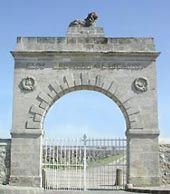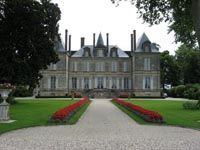 | The vineyards of Léoville-Las-Cases lie in the northernmost corner of the Saint Julien appellation, abutting the Gironde, and only separated by those of Chateau Latour to the north by the Juillac, which drains into the Gironde. Whereas the other Léoville vineyards, those of Barton and Poyferré, consist of a patchwork of numerous plots, those of Las-Cases are largely concentrated in this single block. This is the Grand Clos, a walled vineyard, the stone wall contiguous with that running around Latour, the highlight of which is the stone archway (above) surmounted by the lion of Las-Cases, which also graces the label. In total the estate borders on 100 hectares, of which half is in the Grand Clos, whilst a significant portion, about 20 hectares, lies inland on the other side of the D2, mingling with the other Léoville vineyards. The vineyards are planted to 65% Cabernet Sauvignon, 19% Merlot, 13% Cabernet Franc and 3% Petit Verdot, with an average age of about 30 years. |
| When finished yhe fermenting, the wine goes into oak, between 50% and 100% new for the grand vin, Chateau Léoville-Las-Cases, depending on the vintage, something in the order of 25% for the second wine Clos de Marquis, and heads off to the barrel cellars which are to the south of the main chai where it rests for up to 20 months. In the Léoville order, Las-Cases is the most impressive of the three estates, the pre-eminent estate in all Saint Julien, the first and most tangible challenger to the first growths, the prime example of a 'super-second', those chateaux that would pretend to the crown of premier cru. Essentially it is what remains of the original Léoville estate, it being the larger part, portions having been carved off in the creation of the Barton and Poyferré vineyards. |  |